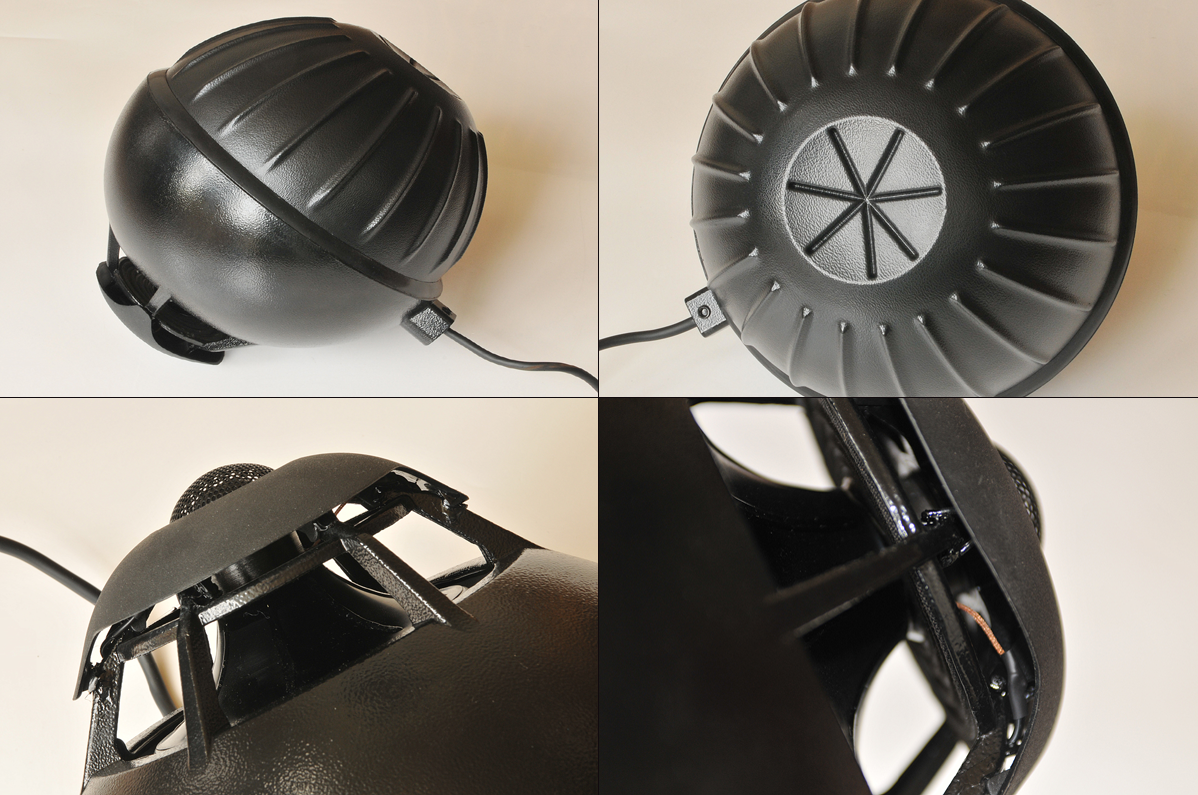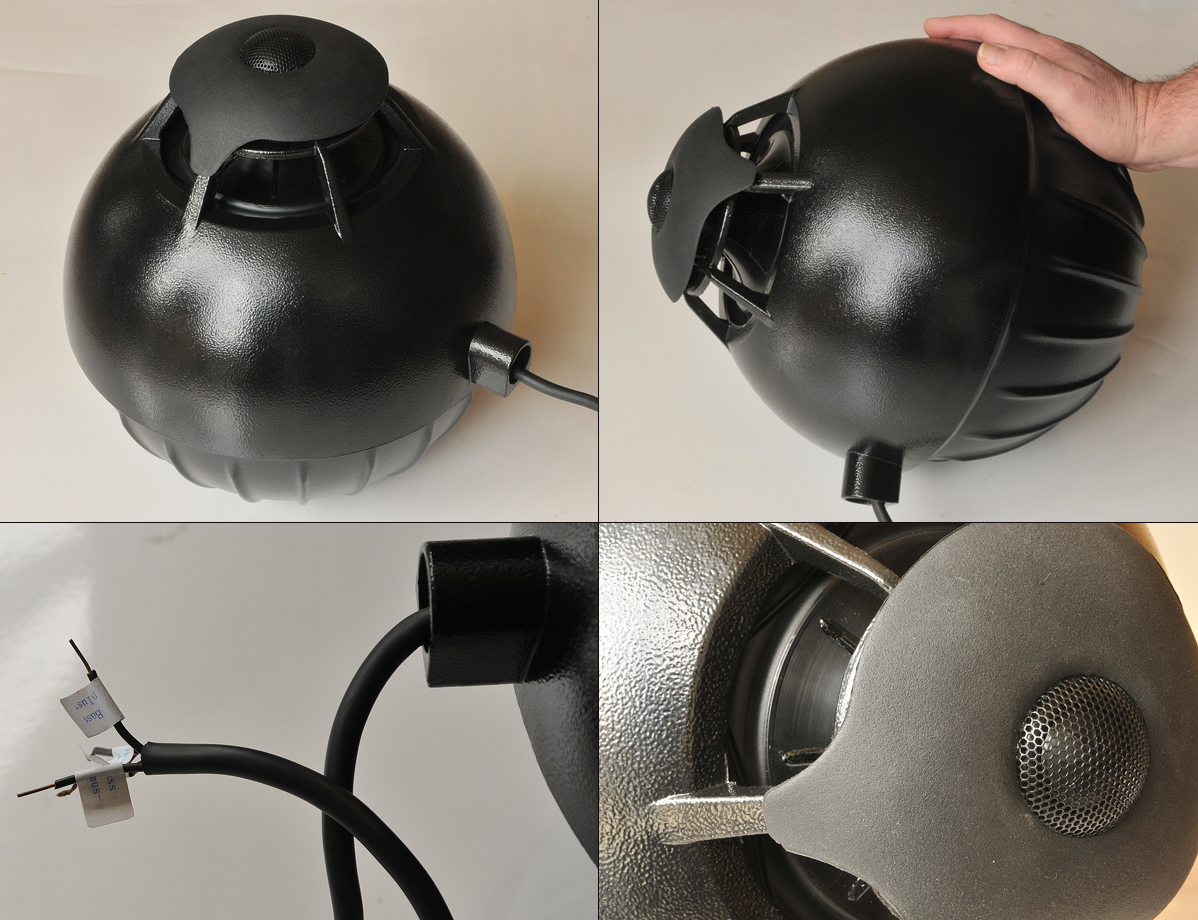 |
|
|
Now to the woofer. Klaus Reck designed the 31cm unit with a dual voice coil. The coils’ diameter is 50mm. Each coil can be driven individually and will withstand 100 watts. Connecting the driver and its horn needs to be done with these dual coils in mind. The membrane gets a cellulose mix with 8 cut slots into which are fitted strips of fiber glass that protrude fore and aft. Their purpose is to reinforce the membrane. Because any sub develops substantial energy, the driver is equipped with large vents not only to cool the coil but also to prevent unwanted pressure between magnet and cone.
Even without hearing what the H-100 might be capable of, the idea and its implementation seemed really well thought through. Constructing an MDF cylinder and fitting its baffle with a custom driver, brace, bottom and top requires labour, hence coin even when done in China. With a going price of €199, something had to give. Enter finish. The cylinder is simply dressed in a black stretch-velvet sock attached with random staples. A black rubber mat with the brand name caps off the top. Admitted the finish could have been worse with a shoddy paint job. Nonetheless our artist in residence was eager to get her hands on the sub and fix its appearance. Another corner cut is the electrical connection. A simple screw-type wire block dangling loose inside the cylinder is the designated receiver for the signal.
|
 |
Onto the next carton. This bigger box contained several smaller boxes and two satellite stands. To begin with these, the Sino manufacturer must have a cling film fetish. The simple stand made of tubular black powder-coated steel was meticulously wrapped in the sticky elastic which took quite some effort to remove. A rubber concealer for the joint between horizontal and vertical part of the stand is provided. Another box revealed a pair of S-30 satellite cleverly packed with the protruding driver parts sitting on a carton tube facing each other. An S-30 active satellite speaker isn’t powered from any built-in module. Hence the nomenclature is a bit unconventional. That matches the speaker’s construction. Reckhorn do their S-30 from two hemispheres forming a 30cm Ø ball. The front half is cast from aluminium, then powder coated. Fixed to it with a bitumen seal is the sphere’s arse end made of black ABS. From the aluminium part protrudes a cuff with a bolt to fix the sphere to the stand’s vertical section. The overall height of the mounted speaker is 90cm.
|
 |
At the front of the aluminium half sits the patented Reckhorn coaxial array. It consists of a 16cm mid/woofer with a 7-slot aluminium diaphragm. A neodymium motor drives the 38mm voice coil. Reckhorn claims a response of 35 – 5’000Hz and 4Ω impedance. This driver mounts inverted to face into the sphere. The tweeter faces the listener fixed to the same motor through its own voice coil. A 28mm aluminium dome is the exciter. Of course this dome is slotted too, this time with 5 cuts. This tweeter claims 1’400 to 20’000Hz bandwidth. A dome-shaped rubber mat acts as tweeter baffle.
|
|
|
|
|
This construction of a bi-directional coax has two advantages according to the designer. One is that the inverted mid/woofer avoids beaming, the second that the tweeter’s radiation is not prone to interfere with the other driver’s radiation. In short, the point-source benefits of a coax without the common driver-inside-a-driver issues. From the cuff used to fix the S-30 to its stand emerges a 4-pole cable. Labels indicate the respective pairs for the tweeter and mid/woofer. What astounded us was the length of the cable. It is up to the user to extend the cable at the recommended gauge, 1.5mm² and 2.5mm² for the tweeter and mid/woofer respectively. However, this cable is too short. The soldered connection between the fixed pig tail and the user’s extension will sit inside the stand’s vertical tube. We’d prefer a longer cable so that a proper connection with a loudspeaker cable may be made past the stand.
|
 |
The S-30 loaners were B-stock. That downgraded rating was due to the Chinese manufacturer not paying sufficient attention to the angling of the sphere’s cuff and the thread in it. Hence the S-30 sat slightly tilted or needed some persuasion to sit right. That plus the unruly thread of the fixing bolt required some elbow grease. At publication time, A-grade samples should be in stock again. It felt like Christmas digging into the endless packages emerging from the bigger box. Next was the A-408 subwoofer amp with parametric equalizer putting 8kg on the scale. That amount of metal sizes up to 425 x 100 x 240mm and delivers up to 450w in mono but at max also 10% distortion. For sub frequencies between 10 and 400Hz, such figures are less alarming than higher up. Turning the volume down drops distortion below 1%. A figure of interest for the control of a woofer is damping factor. Reckhorn states that the A-408 is good for 250. When the low input is used, the preamp sees a load of 10KΩ whilst the sensitivity of that input is a very high 0.3V. The satellite speaker input is a lower 1.2V.
|
|
At the front of the A-408 there is a power switch and two LED indicators for protection mode and clipping. Then come 9 knobs as controls for the parametric equalizer. Starting with the subwoofer level, there are controls for the high-cut frequency, boost level (0 to -7.5dB), boost frequency (15-55Hz), equalization level and frequency (17-85Hz), the -24dB subsonic filter range (10-50Hz), output phase and the low-cut frequency for the satellite (30-400Hz). At the business end of the A-408 there’s the low-level input followed by satellite outputs. The high-level input is formed by a 4-screw terminal and the subwoofer output is a 2-screw affair. A ground lift switch and AC receptacle complete the back. As the A-408 is also useable with DSP hard/software which we think is much more fun, we concentrated on that option.
|
 |
|

|

|
|